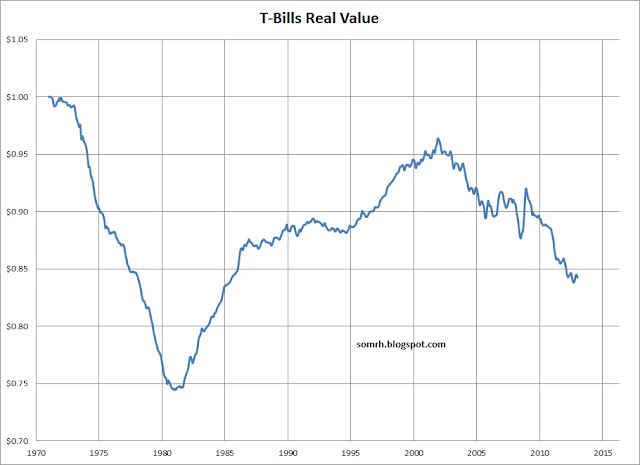If you've ever had the "privilege" of reading an economics textbook, it will give you a functional definition of money - money is defined in terms its functions. For example, according to the wikipedia article on money, money serves the following four functions:
- Medium of Exchange
- Unit of Account
- Store of Value
- Standard of Deferred Payment
As far as the dollar is concerned, it's frequently acknowledged to satisfy 1, 2 an 4 but not 3. I can use dollars to make all sorts of purchases (medium of exchange), all of the goods and services and debts are denominated in dollars (unit of account) and all of my debts can be dispelled by the use of dollars as a result of legal tender laws (standard of deferred payment).
But regarding store of value, the dollar has not served so well. As I illustrated in Figure 2 from my blog on Currency and Price Stability (reproduced here), the dollar has lost a significant amount of purchasing power over the years.
So I think we can safely question the status of the dollar's store of value.
But wait, doesn't the title of this article suggest that the dollar is an excellent store of value? So let's spell this out a bit.
Above I noted that money is typically defined in terms of its functions and that the dollar has largely failed in one of its functions: store of value. But what if we actually had two currencies, one which satisfies 3 of the functions and one which satisfied the fourth function?
Two Kinds of Currency
I'm going to propose two kinds of currency which I'll call "Saving money" and "Spending money". The latter will fulfill the function of medium of exchange, unit of account and standard of deferred payment; the former will fulfill the function of store of value.
Now I'm going to further contend that this system is already in place. What we traditionally call dollars are "spending money" whereas savings bonds, t-bills and treasury bonds are "saving money".
So the question is: are dollars (as in savings bonds, t-bills and treasury bonds) a good store of value?
The historical data indicates that they are. For example, consider this article:
Treasury Bills and Inflation
Here's a look at 3 month T-Bills and the loss of value in the post-Nixon era (I assumed, as the above article did, a 28% tax rate):
Apart from the initial setback, the dollar has been pretty stable. Had one mixed in some longer dated treasuries, one would have a good deal better.
Now the current low interest rate environment will likely result in a loss of value by putting one's savings in t-bills. As of today, one has to go out to 20 year T-bills before one finds a positive rate of return.
But I will say that my initial claim - The Dollar is an Excellent Store of Value - is a bit overstated. Nonetheless, if one looks at our economy as having two types of dollars (savings and spending) then we can say that the saving dollars have been a pretty decent store of value.
This suggests a different picture regarding the Fed's operations. In a post-Nixon era, what the Fed typically does is trades one US government stamped piece of paper (spending money) for another US government stamped piece of paper (saving money). So in a sense, the Fed doesn't add to the total stock of money. (Granted, in recent years it's been buying MBS so that's no longer entirely accurate.)
I'll close with the following chart (data provided by FRED). This gives you a bigger picture of what total US financial assets (saving dollars and spending dollars) looks like:
As can be seen, the monetary base (M0) makes a miniscule portion of the total money supply and a relatively small percentage of total money in general, most of which is created by the private banking sector.
Furthermore, total savings money (M2) represents only about 40% of total money. That figure has been declining for most of the history presented here (it was as high as 67% in 1975).












This is pretty awesomely subversive. Great post somrh (Samuel?) It cuts at the heart of all the "end is near" economists. (You'll never be linked to zerohedge...)
ReplyDeleteBut what about the fact that the average person saves their money in spending money, and barely anyone saves money in saving money. Is there a discrepancy between what is technically true and what is happening in the accounts of average USD holders?
I thought the average person was borrowing not saving :)
ReplyDeleteFrom a social standpoint, I think we need adequate financial education. It just isn't there. Our financial world is pretty complicated so I think we, sadly, need it.
Inflation probably hits those living on a fixed income and the poor the hardest (many of the latter don't even have bank accounts, much less avenues for savings... assuming they even have money to save.)
A while back I had the thought of something along the lines of "national bank accounts". It would tie, say, the first $10,000 into CPI in some way. Something like that would reduce the effects of inflation at least on a base savings (emergency funds). After $10,000 you should probably find something more productive to do with it (sticking dollars or pieces of shiny metal under a mattress isn't exactly productive.)